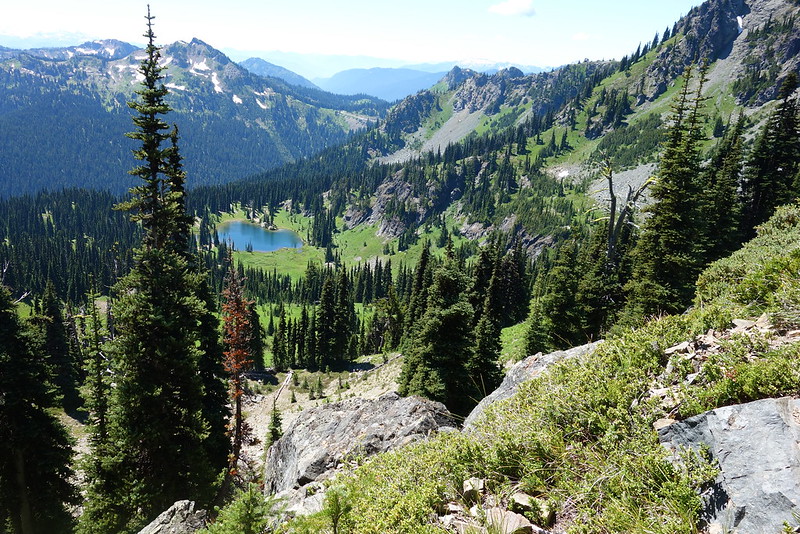
Opening picture: Sheep Lake and Chinook Pass, from near Sourdough Gap.
Section I has a split personality. For the first fifty miles, it passes through wonderfully varied wilderness: subalpine lakes through the William O. Douglas Wilderness; steep, rocky ridges on the eastern tip of Mt. Rainier National Park and southern half of the Norse Peak Wilderness; and deep, old forest as it descends through the northern half of Norse Peak. But then, between the Norse Peak Wilderness boundary and Snoqualmie Pass, it enters a checkerboard of public and private land, all touched by a long history of logging: clearcut scars to the horizon; charred trees from a fire started by loggers; dozens of hastily built roads; and water made scarce by impoverished soil. I'm not categorically against logging, but walking through the second half, through the sorts of scars that often remain hidden from main roads and routes, I couldn’t help but think that there must be a better way.
Day 7 (July 23): Zero in White Pass, Packwood, and Randle
I slept hard in the motel at White Pass, and was only vaguely aware of my buddies from the night before waking up early to hike on. They had a long day, trying to get up south past Old Snowy. I had an easy day of eating and doing nothing with Krista.
My alarm went off a couple minutes before eight, and I wandered sleepy eyed down to the store to get a load of laundry going before the place got crowded. There were already a half dozen hikers there, drinking coffee and indiscriminately ordering off the brief breakfast menu. I said my hellos, put my clothes in the store's elderly washer, and rambled back to my hotel room for breakfast.
I spent the next couple hours eating extra food in the hotel room, meandering back and forth to the store to deal with laundry, and generally just loitering. After six days on the go, it felt really nice just to bumble around doing nothing.
I checked out around ten, spent a while saying goodbye to the wonderful woman who runs the place, and went to go meet Krista at the store. Krista! In real life, weeks always seem to go so fast. But the last week hiking had felt like a month, and seeing her felt like years ago when I was in grad school living in Eugene, and we'd only get together on special weekends.
She pulled up in our little Honda, I jumped up and down like a nutcase, and we drove off together, to tourist around Rainier and eat around Packwood.

We'd reserved a hotel room in Randle, at the unexpectedly fantastic Tall Timber Motel, where we eventually landed and settled in for an evening full of trashy TV and, again, unexpectedly fantastic pizza from the attached restaurant.
Day 8 (July 24): White Pass to Dewey Lake
PCT 2292.4 - 2317.9 (25.5 miles)
The next morning was an echo of the morning I left: our alarms went off, but neither of us wanted to get up, because getting up meant saying goodbye. So we slept late, schedules be damned.
Eventually though we did get going, stopped for coffee in Packwood, and made it back to White Pass too soon, to say our too quick goodbyes. But it was somehow easier this time: having made it a week, making it another few seemed more possible, if still hard.
Happy and full from my weekend of rest, I basically bounded up the trail into the William O. Douglas Wilderness, and soon entered a large, flat plateau dotted with dozens of lakes and hundreds of ponds and thousands of hungry mosquitoes. It was beautiful, but probably would have been more so if it hadn't been made blurry by the fact that I was running through to escape the bugs.
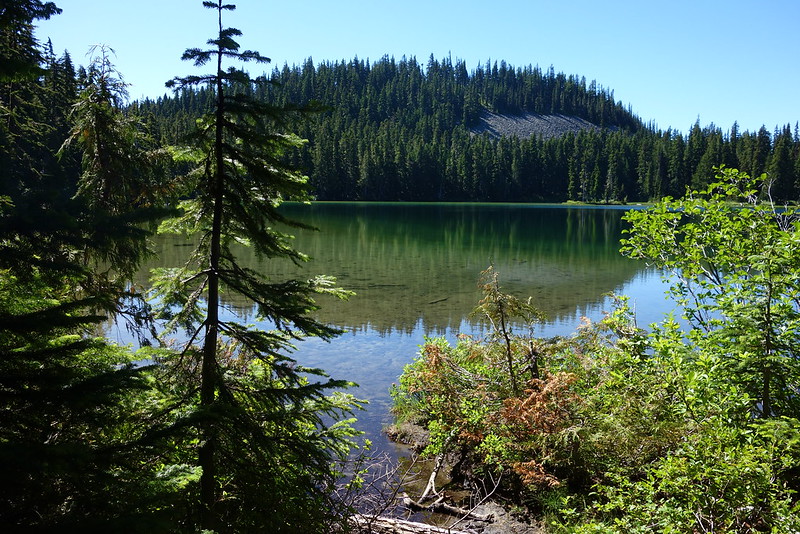
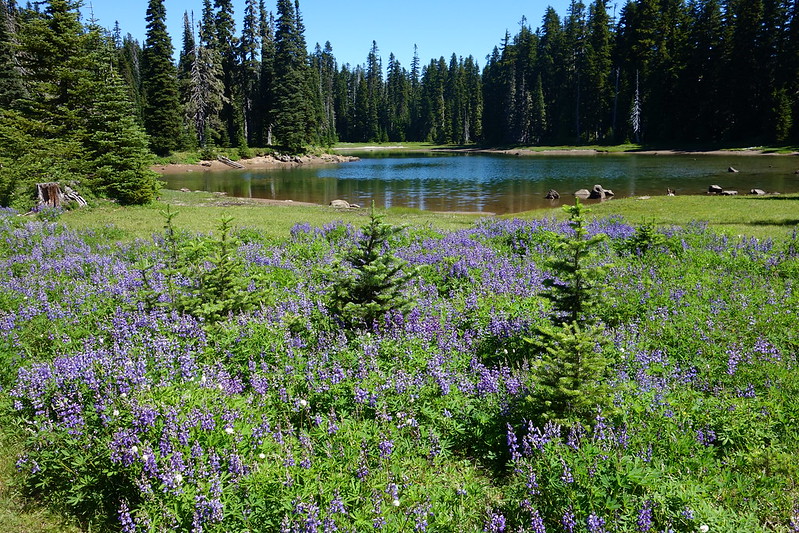
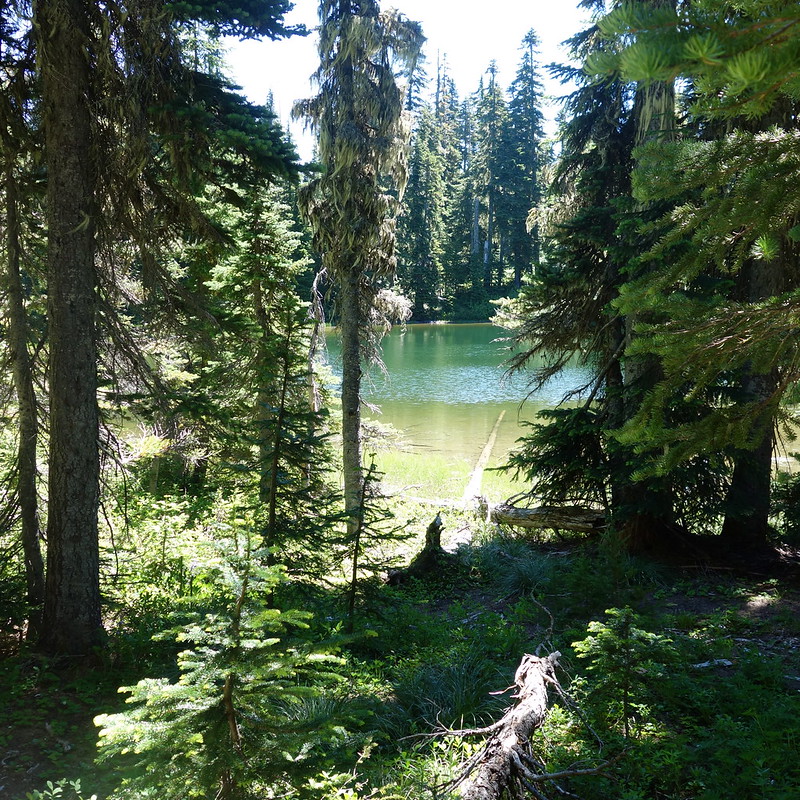
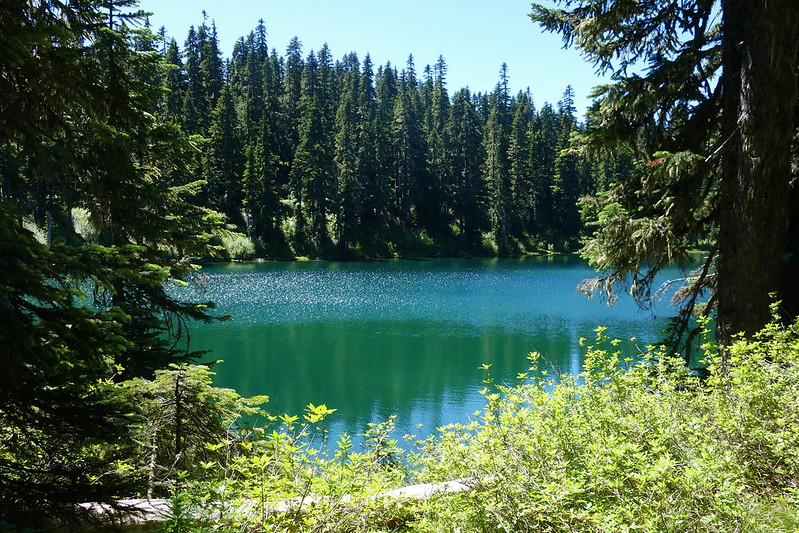
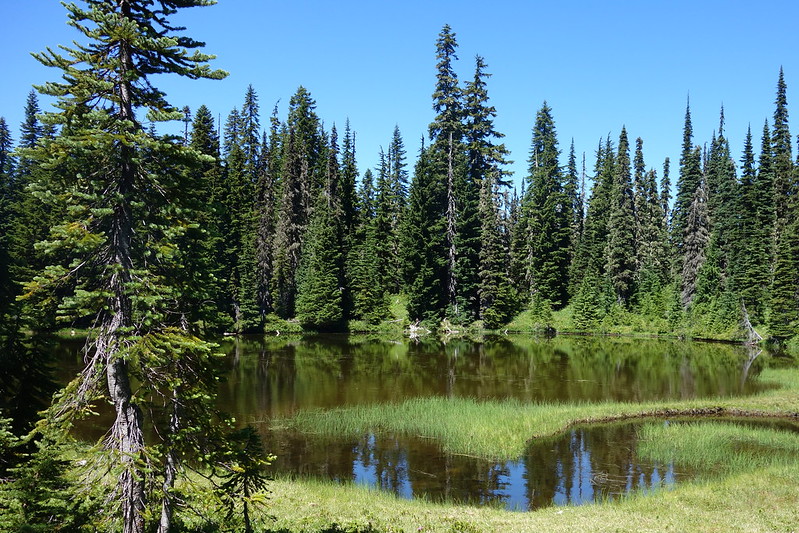
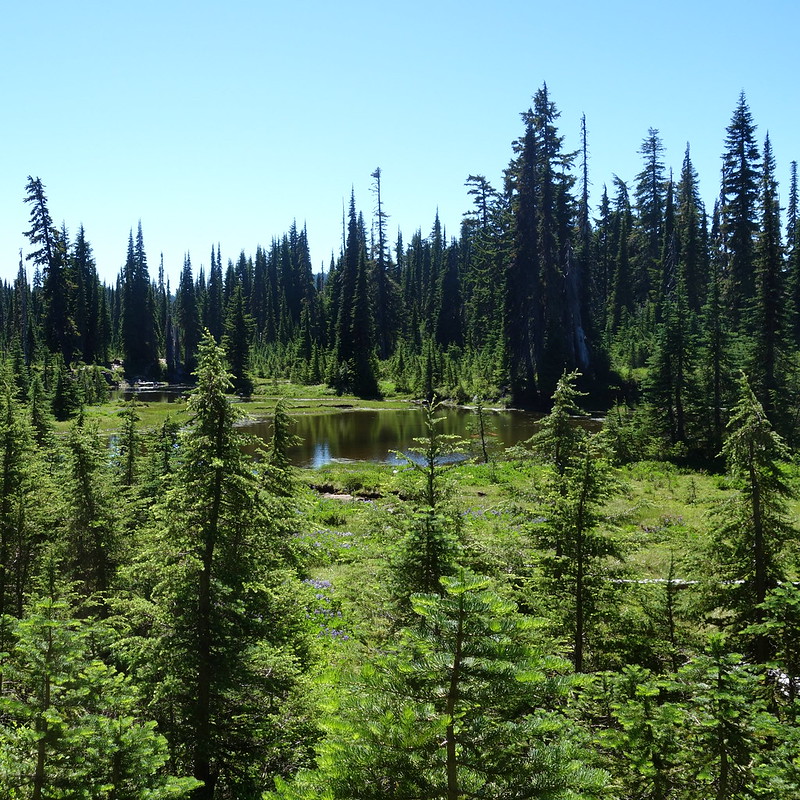
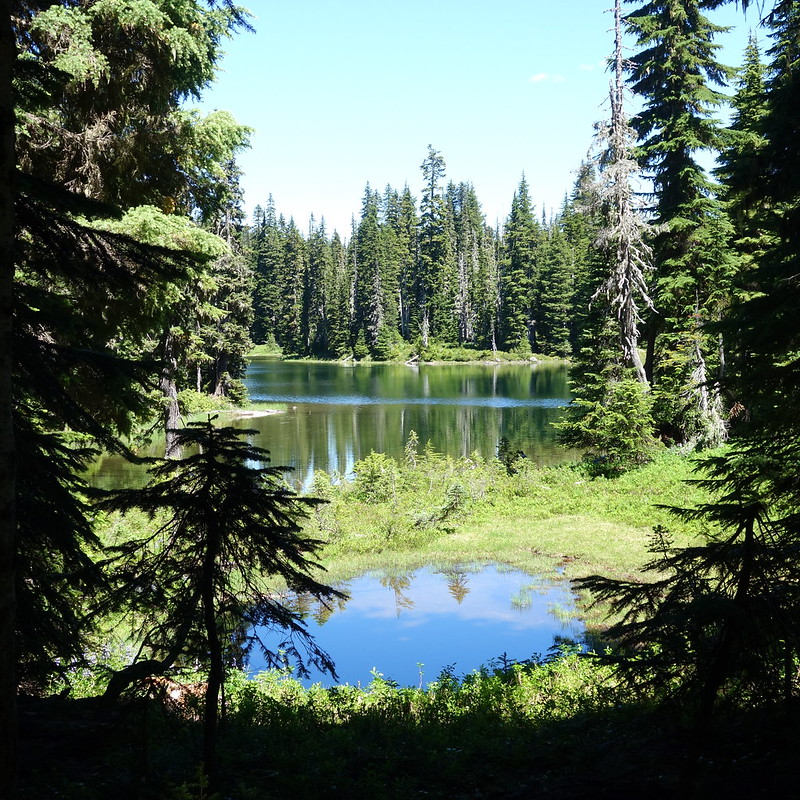
Near the northern tip of Snow Lake, I ran - almost literally - into the first of many southbound PCT hikers I'd meet that day: a woman in her mid-20s, who gamely stopped to chat for a while, despite being immediately covered by mosquitoes. She'd started at Harts Pass, gone up and back to the border, and had now been walking south for a few weeks, doing long days through last week's storms. "It's beautiful up there when you're not in a cloud." And then she paused, laughing. "I guess the clouds are okay too."
Talking to her, I thought about the strange rhythm of thru hiking. Last year on the JMT, it was more or less one sunny, spectacular day after another. There'd been smoke in the afternoons, but tall clear spires of granite every morning. Here, in Washington, the day's delights were sometimes more subtle: a few ponds, a rushing stream, sometimes, but not always, the most beautiful mountains you've ever seen. Some days will be spent all in clouds, with views extending only a few feet. Some days will be spent doing little beyond running from the bugs. And yet other days will be spent on high ridges, with views for hundreds of miles so beautiful you'll have to sit down.
As we said goodbye and I began a long, steep descent to the Bumping River, I thought about something I'd read just before leaving on this trip, from William O. Douglas, the environmentalist Supreme Court Justice for whom this whole area is named. Recounting a series of illnesses later in life, Douglas recalls remembering this place - the Bumping River, the Goat Rocks, Mount Adams - from his sickbed, and the memory bringing him back into the world:
Thinking of Douglas, I realized that, in all probability, I'll remember all of these days: the ones on stark peaks with views for miles, but also the ones in boggy, buggy, viewless forest. And they'll all remind me of what it means to be in the world.The Cascades have been particularly undeniable when I have lain in sickbed. In days of fever and sickness I have climbed Mount Adams, retraced every step from Cold Springs to the top, recrossed its snow fields, stood in an icy wind at its highest point, and there recaptured the feel of adventure and conquest and the sensation of being back millions of years at the time of the Creation.
During hospital days I have explored many streams of the Cascades, looking for the delicate periwinkle. I have cast a fly on dozens of their lakes, and searched the pools of the Big Klickitat, the South Fork of the Tieton, Bumping River, and the Naches for rainbow trout. I have sat on the crags of Goat Rocks 500 or 1000 feet below the summit, waiting for a mountain goat to appear in silhouette against the skyline. I have seen lively bug hatches on Fish and Swamp lakes. I have heard the noise of elk in the thickets along Petross Sidehill.
These have been haunting memories that in illness returned me to the world of reality even when it seemed I might be close to the other side of the river.
I forded the Bumping River with no difficulty, then set out up a long series of switchbacks past Buck and Crag Lakes to the Cascade Divide, here a craggy ridge that the trail traverses, hopping back and forth across the crest between minor saddles, most of them hiding unlikely lakes.
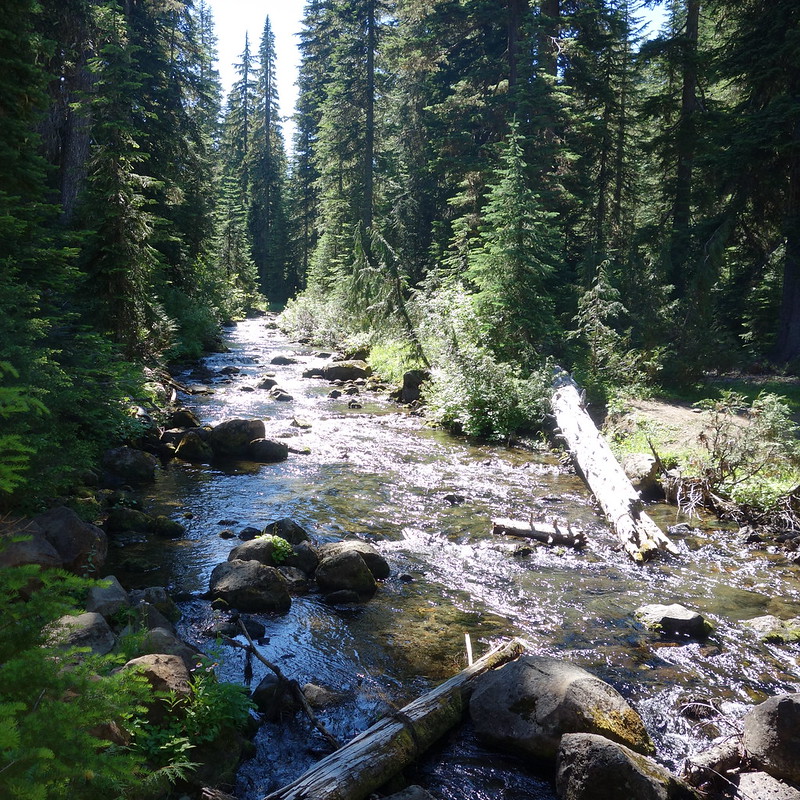

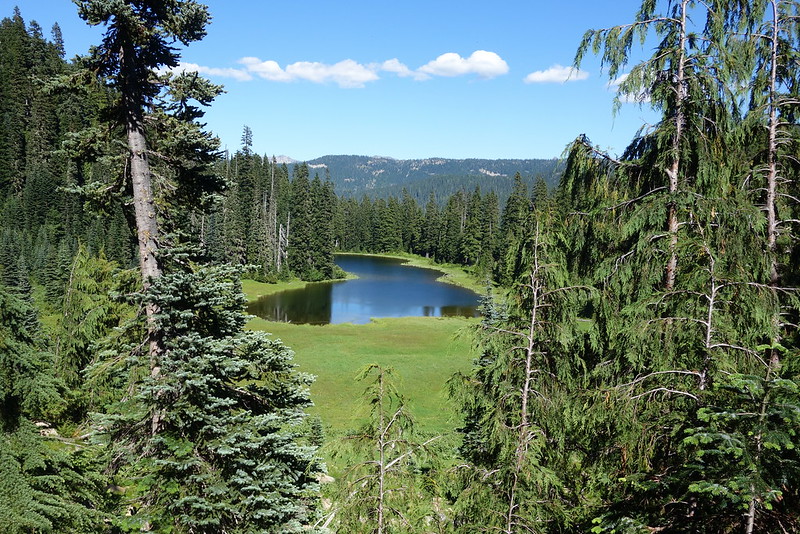
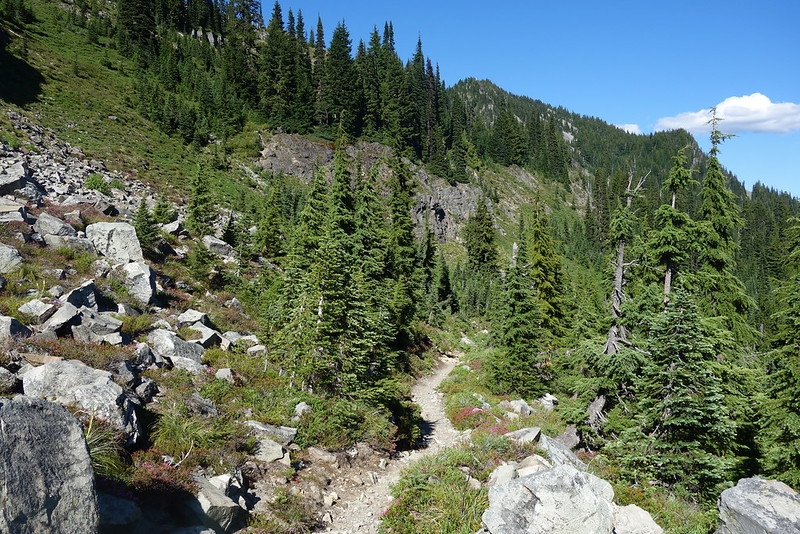
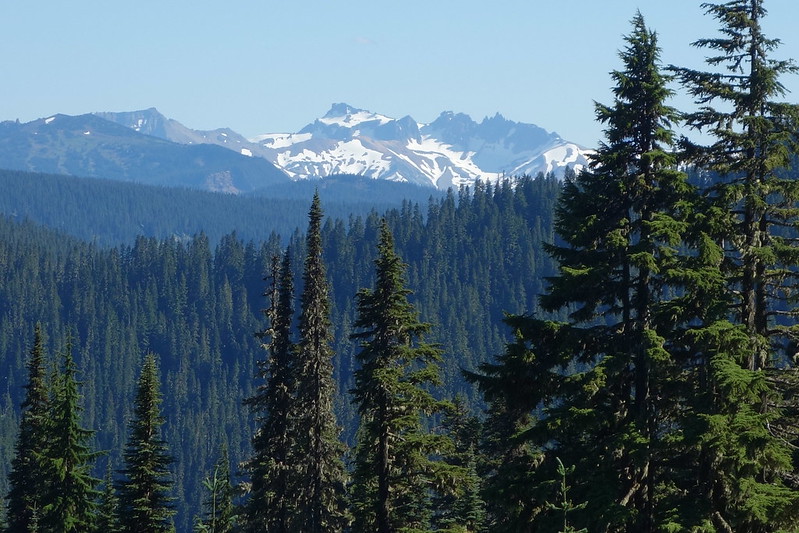
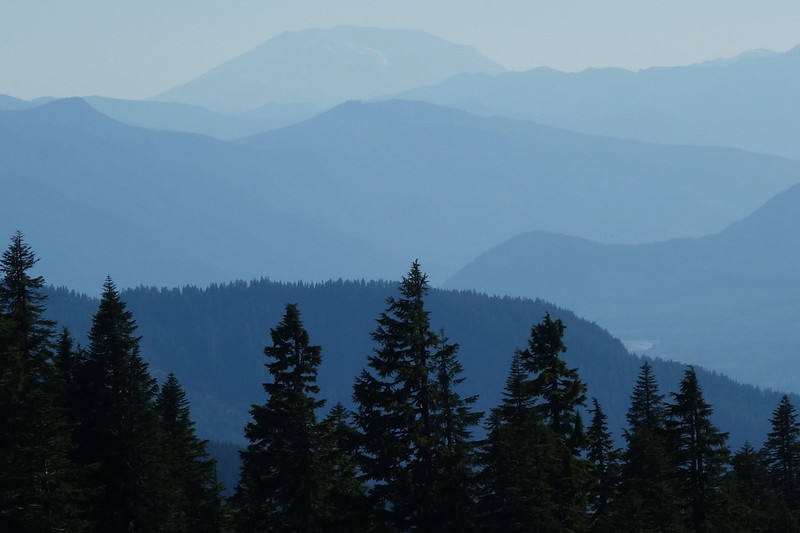
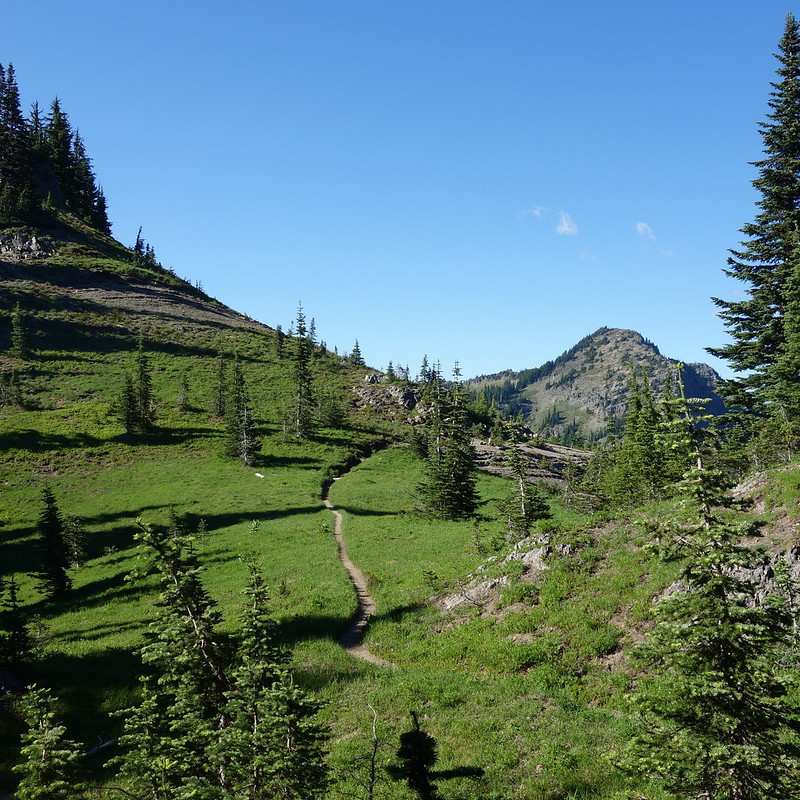
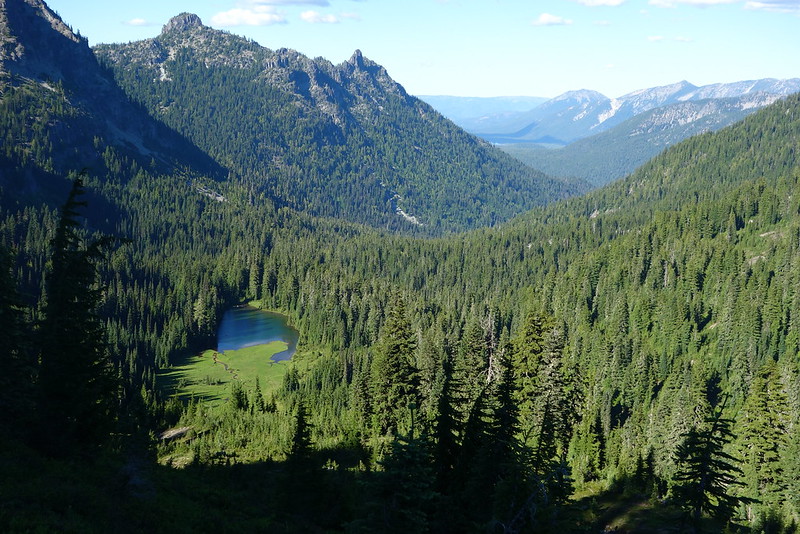
In short order the trail entered Mount Rainier National Park, and, as if on cue, the mountain began to haunt every corner, a washed out specter in the harsh afternoon light.
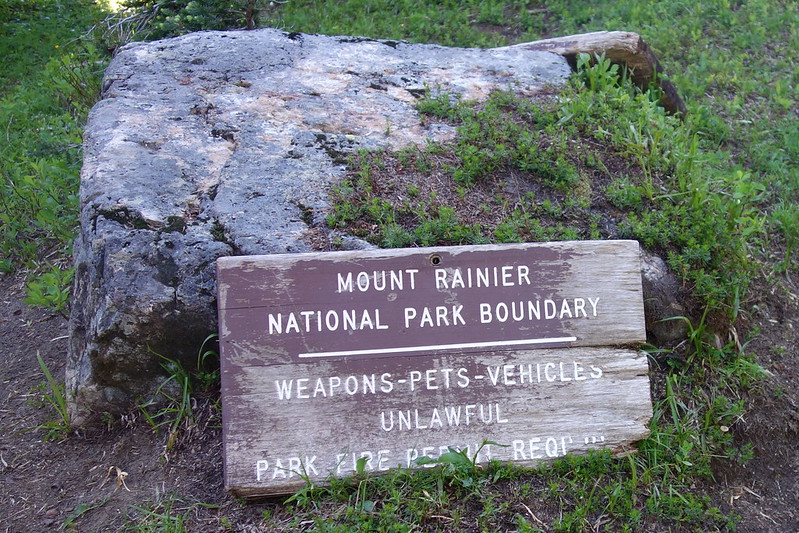
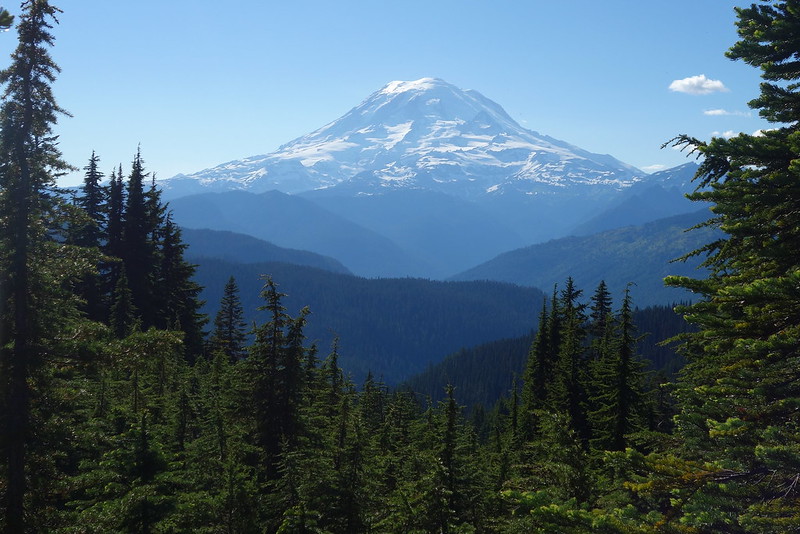
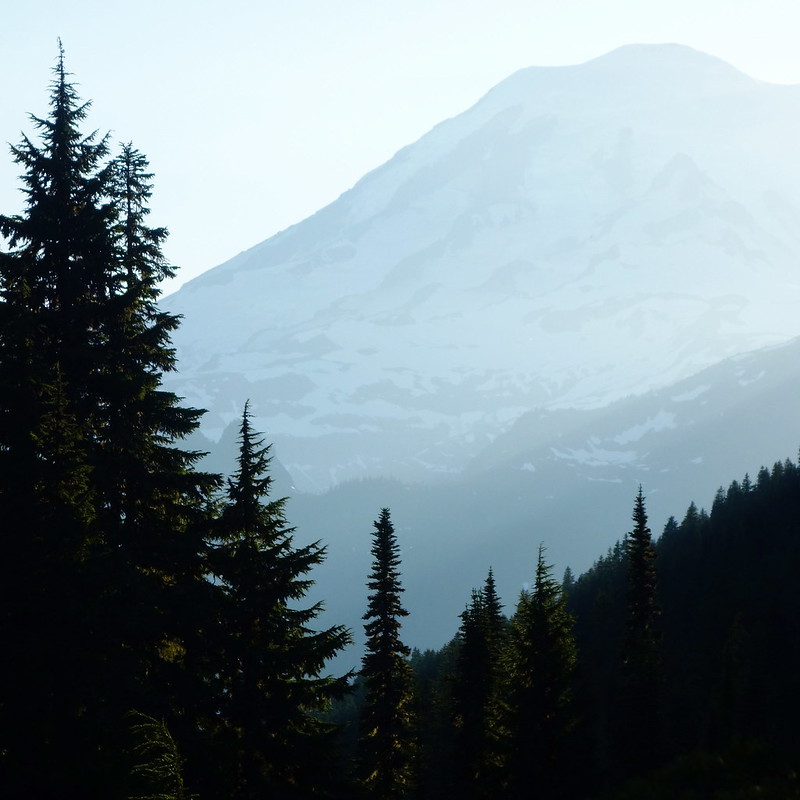
The afternoon passed pleasantly on the rolling ridge, among snowfields and fresh, meltwater streams. I stopped at one to filter some water, then continued on, feeling happy and easy in the fading light.



I'd planned to camp at Anderson Lake, but when I arrived I found the only suitable camp already full to the brim with tents. So I settled for a single picture, then continued on to Dewey Lake, several swampy miles further.
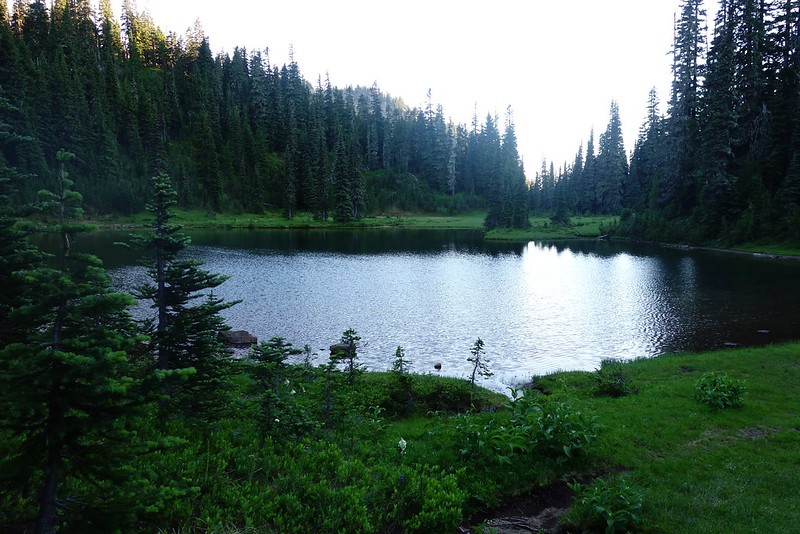

Dewey Lake was unexpectedly full for a Sunday night, but the sites still outnumbered the campers, and I quickly found a large, luxurious spot on the lake's southern shore. It was nine by the time I got camp set up, and I was too tired for a proper dinner, so I ate a second lunch, had a few sips of bourbon, and settled into my tent to the sound of a hundred frustrated mosquitoes, trying to get blood through the bug net.
Day 9 (July 25): Dewey Lake to Arch Rock Spring
PCT 2317.9 - 2339.1 (21.2 miles)
I think the mosquitoes slept on my tent. Or in any case they were up before me, poking hopefully through the netting as the sun rose over the American River below and flooded the lake with light.
It was a fumbling, clumsy morning trying to pack up among a million mosquitoes. But forty minutes and forty-thousand bites later I finally did get going, at first around the lake to visit the dozens of neighbors I hadn't seen the night before, then up and around the southern flank of Naches Peak, through small tarns toward Chinook Pass.
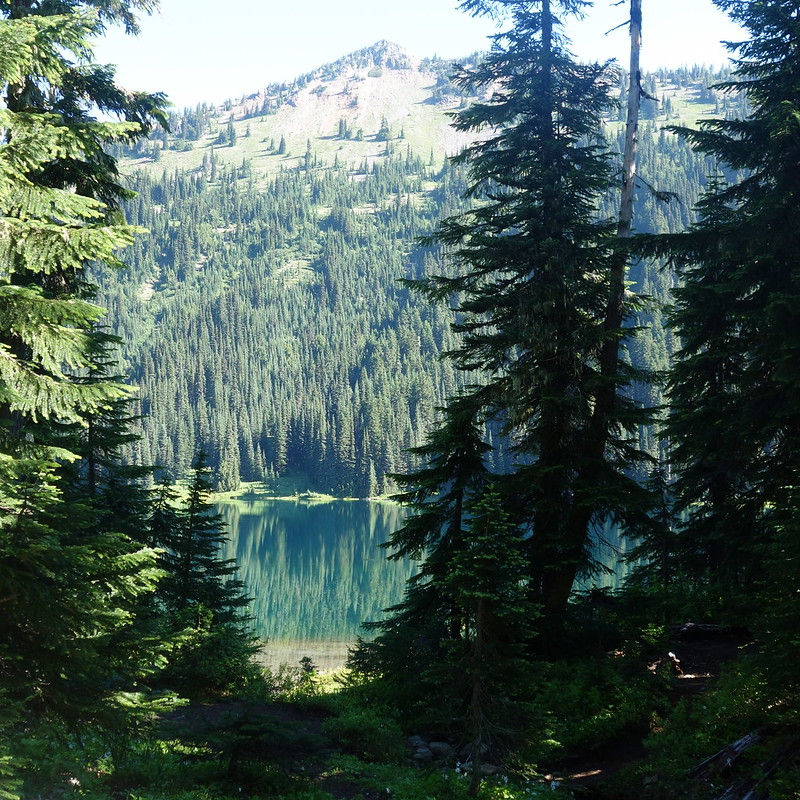

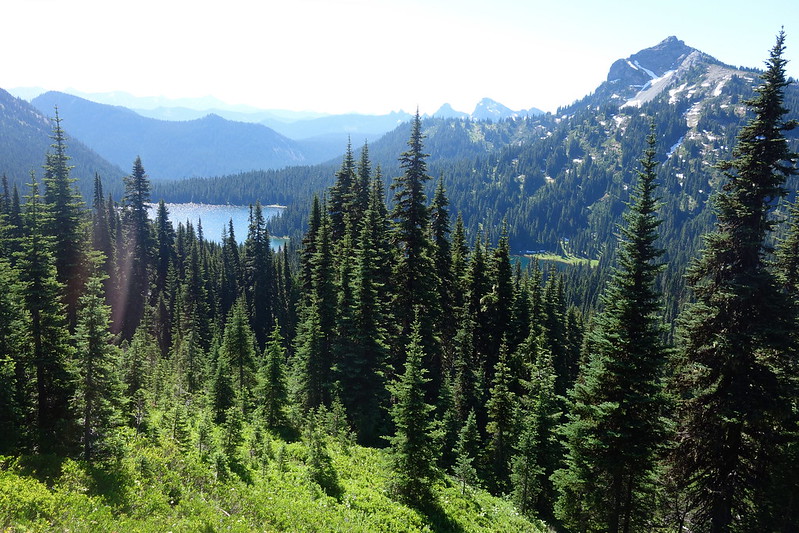
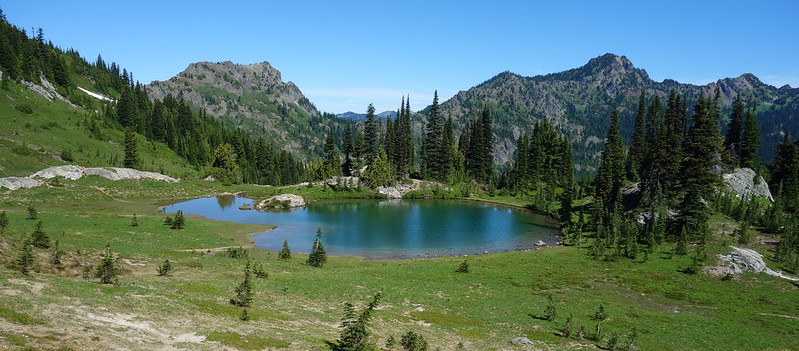
Descending to the pass was something of a shock. I passed dozens of day hikers, some friendly, but many with the sorts of stern, determined looks that seem to indicate a strange understanding of the wilderness, wherein every ramble through the woods is an opportunity to conquer something. Several times the trail was blocked by big groups taking pictures with PCT signs. At one such obstruction, I heard a middle aged man tell his teenaged son that he could tell people he'd gone "further than that Wild girl." After a short, baffled pause: "She stopped in Cascade Locks." Seriously?
After crossing the highway, the crowds thinned considerably, and I thought about all those people taking pictures with PCT signs. It would be easy to mock them, and some of them seemed almost to be mocking themselves. But I also kind of understand it - that desire to see this famous trail, if only for a short morning stroll. If anything, the whole scene just made me feel lucky: lucky to have the opportunity to know this place in a deeper way, to see views beyond the highways.
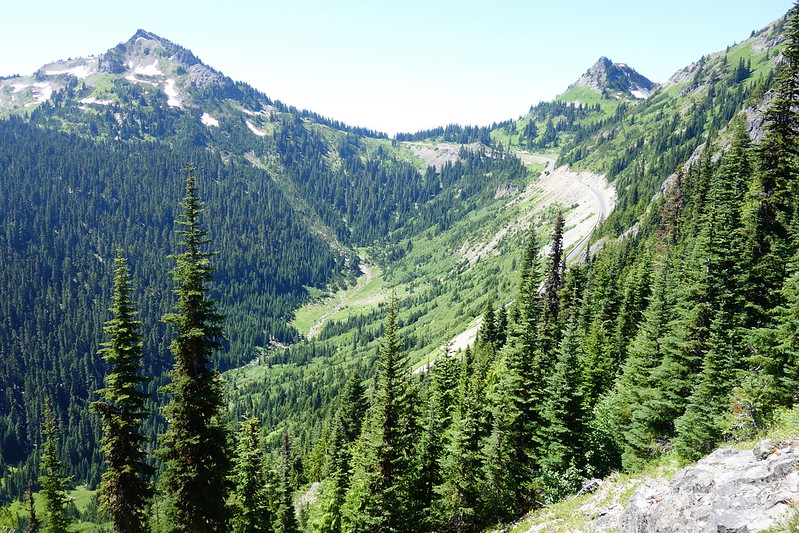
From Chinook Pass, the trail parallels the road for a short ways, then cuts up a steep draw to Sheep Lake, a painfully beautiful bright blue pool in the shadow of the Cascade Divide.
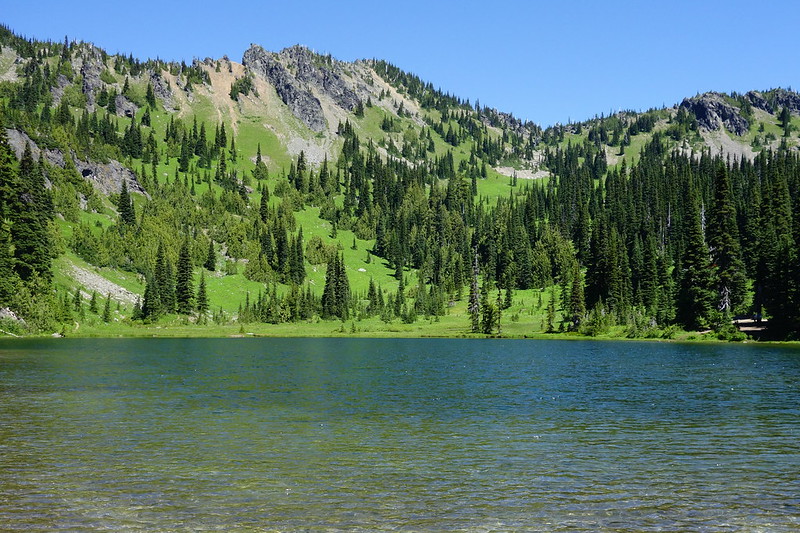
Beyond the lake, the trail climbs again, several hundred hot feet to Sourdough Gap, which marks the trail's entrance into a seemingly endless system or ridges, valleys, and basins.

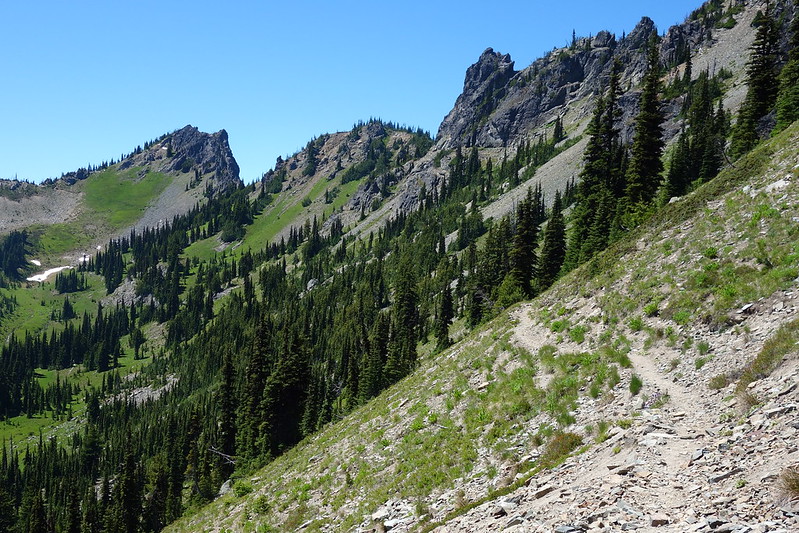
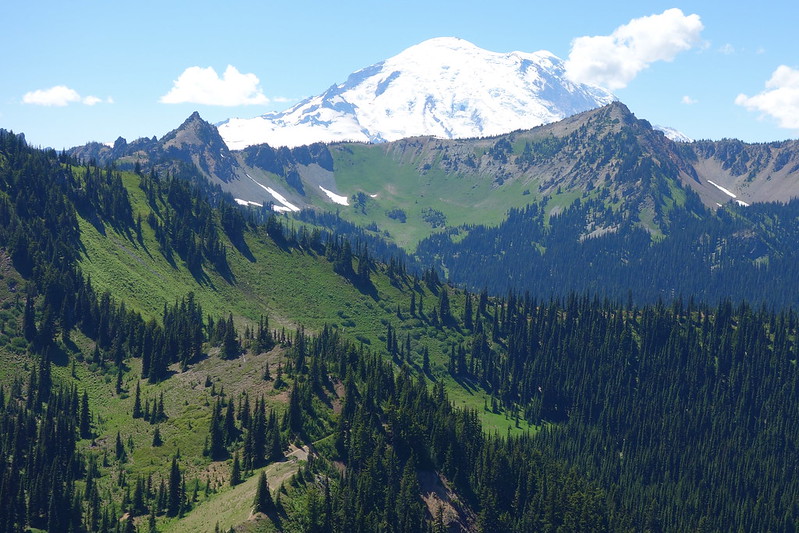


Near Scout Pass, I met a friendly, chatty dayhiker out from Seattle. When I told him I was from Portland, he smiled broadly. "You can see Mount Hood from there!" I smiled back, though I didn't know quite what to say to this, and he continued on unabated. "You know, if you found the right ridge, you could probably see Mount Hood from here, too." As I said goodbye and continued on across the Lakes and Big Crow Basins, I imagined that, if you found the right ridge, maybe you could see the whole world from here.
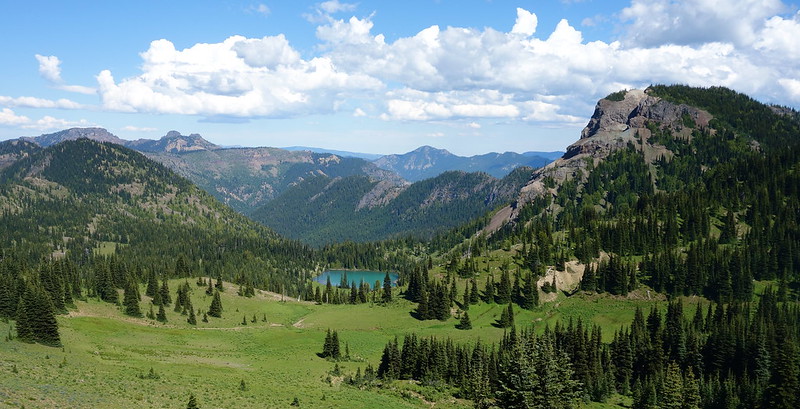
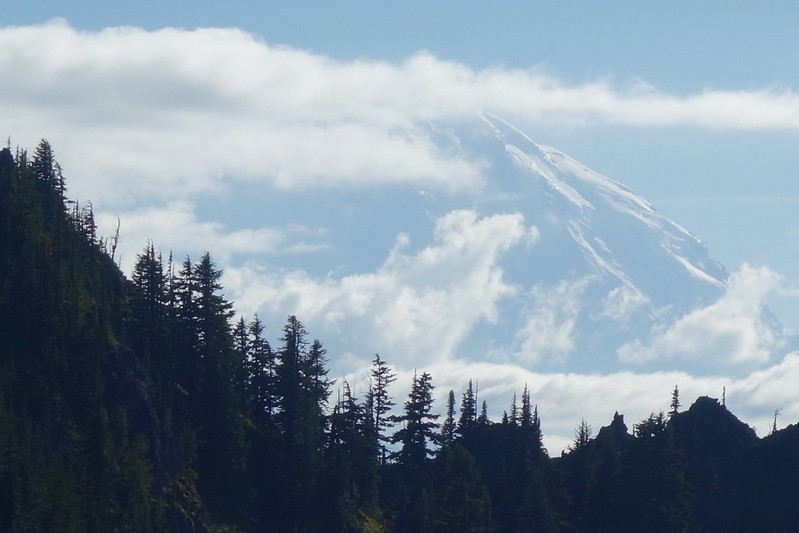
Eventually the ridges faded to flatter forest, which passed easily as I approached my camp for the night: an unnamed spring just below Arch Rock. I made camp quickly, washed off my arms and legs and face in the trickling water, and ate a slow dinner as the shadows grew long and the harsh afternoon light became a gentle glow.
Day 10 (July 26): Arch Rock Spring to Tacoma Pass
PCT 2339.1 - 2361.6 (22.5 miles)
I woke up ready to walk, quickly packed up camp, and sped pleasantly through the deep, old forest at the northern edge of the Norse Peak Wilderness. Here and there were thick stretches of blow down, but somehow it didn't bother me. I thought of Bell Creek, or some of the other lesser traveled trails in the upper Columbia Gorge. It reminded me of home. How wonderful to live the sort of life where old growth reminds one of home.
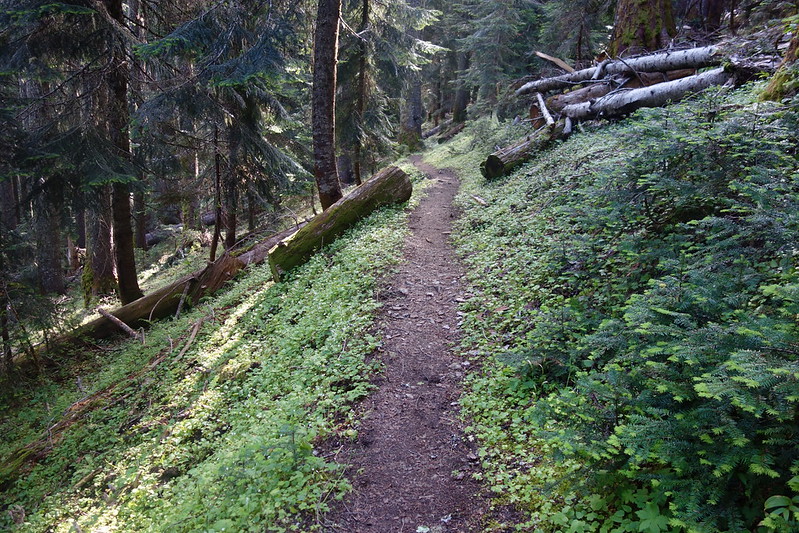
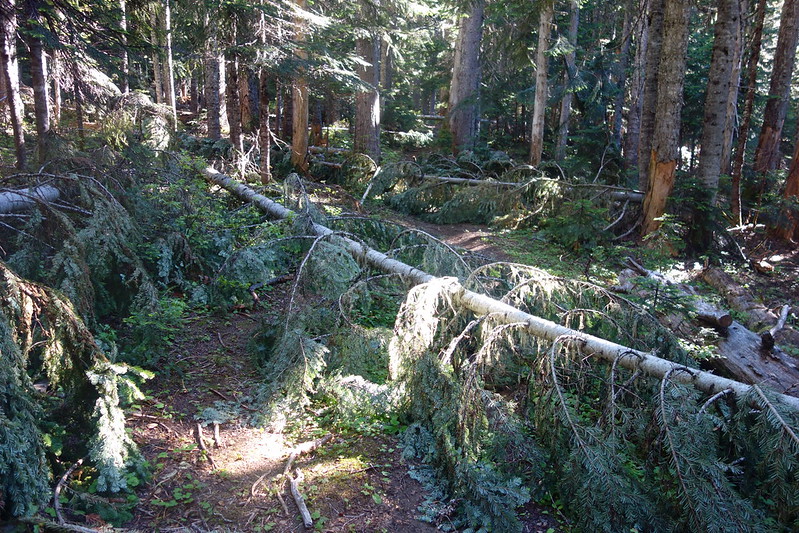
I stopped for breakfast just past the Norse Peak boundary, at an old ski cabin on the edge of Government Meadow. The cabin itself was hot and buggy and smelled like a thousand campfires, but the open woods around it were lovely, and I sat for a while, watching the meadow for deer. Just as I was packing up I was joined by a couple thru-hikers, and we chatted pleasantly for a while about gear, and about their recent unhappy discovery that duct tape is, in fact, flammable.
After the cabin, the scenery suddenly changed, from deep forest to land deeply scared by countless clear cuts, bulldozed paths and broken trees, and the tangled remains of a fire accidentally set by loggers in the late 80s.

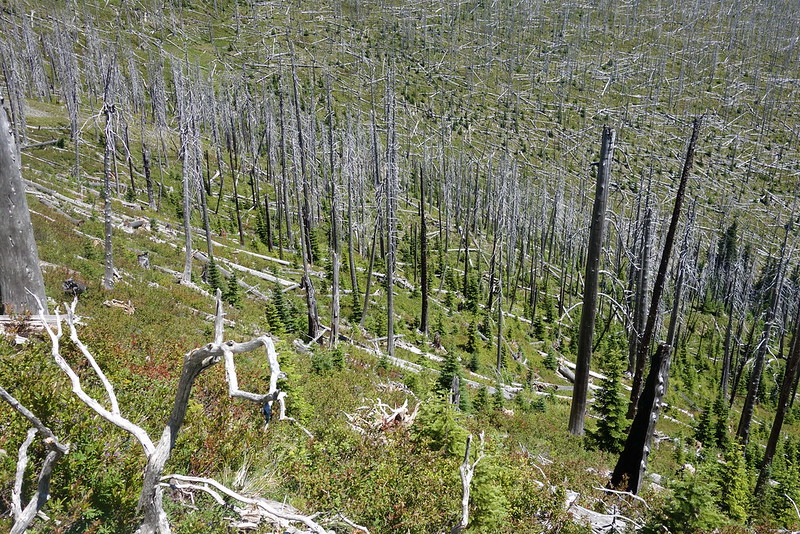
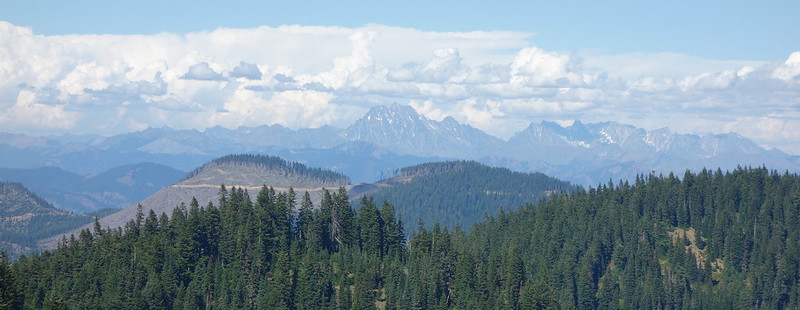
I stopped for lunch at a small spring on the side of a dusty logging road, the last water for 11 or 12 miles. One of the things I hadn't realized before this trip was the extent to which this sort of logging transforms entire ecosystems. It's not just the obvious lack of trees, but also the less obvious impoverishment of soil, and the long term changes it causes to the whole wilderness.
And I thought again of Douglas, this time in his role as a Supreme Court Justice, writing his famous dissent in Sierra Club v. Morton, arguing that the environment itself should have some sort of standing in human law:
For miles, the trail climbed in and out of clear cuts, along dusty roads, and through precious scraps of forest, left intact by the checkerboard pattern of property ownership in this part of the Cascades. Eventually, it began a long wooded descent down to Tacoma Pass, where my maps marked nearby water and a few campsites.The critical question of "standing" would be simplified and also put neatly in focus if we fashioned a federal rule that allowed environmental issues to be litigated before federal agencies or federal courts in the name of the inanimate object about to be despoiled, defaced, or invaded by roads and bulldozers...
Inanimate objects are sometimes parties in litigation. A ship has a legal personality, a fiction found useful for maritime purposes... So it should be as respects valleys, alpine meadows, rivers, lakes, estuaries, beaches, ridges, groves of trees, swampland, or even air that feels the destructive pressures of modern technology and modern life. The river, for example, is the living symbol of all the life it sustains or nourishes - fish, aquatic insects, water ouzels, otter, fisher, deer, elk, bear, and all other animals, including man, who are dependent on it or who enjoy it for its sight, its sound, or its life. The river as plaintiff speaks for the ecological unit of life that is part of it. Those people who have a meaningful relation to that body of water - whether it be a fisherman, a canoeist, a zoologist, or a logger - must be able to speak for the values which the river represents and which are threatened with destruction...
The voice of the inanimate object, therefore, should not be stilled... Before these priceless bits of Americana (such as a valley, an alpine meadow, a river, or a lake) are forever lost or are so transformed as to be reduced to the eventual rubble of our urban environment, the voice of the existing beneficiaries of these environmental wonders should be heard.
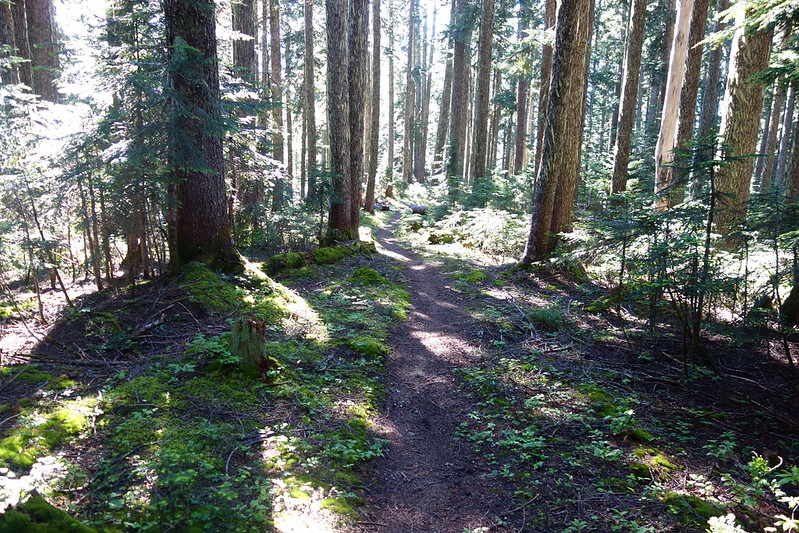
The spring, a quarter mile off trail just above the Forest Service road that marks Tacoma Pass, was like some strange oasis. After a dusty, disconsolate day, it was there, a still standing sign of the wilderness that used to encompass this whole area. I drank a few liters with my feet in the water, and wished for a nearby flat big enough to house my tent.
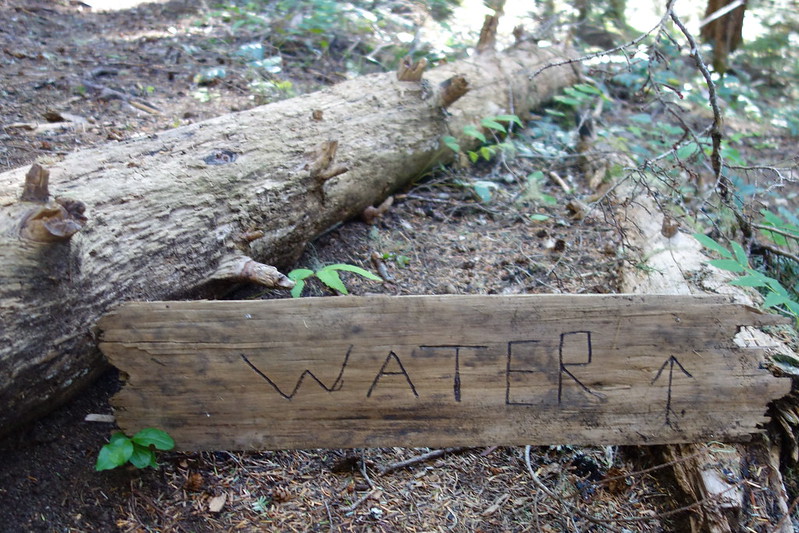
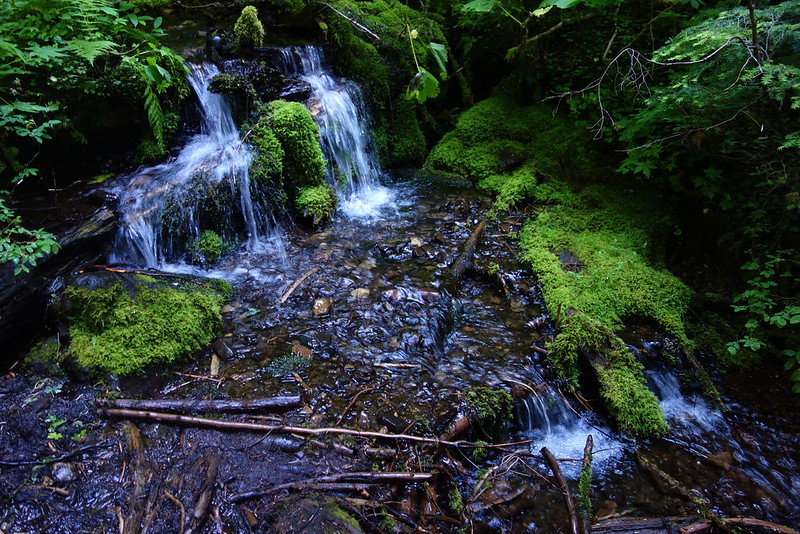
Day 11 (July 27): Tacoma Pass to Mirror Lake
PCT 2361.6 - 2382.1 (20.5 miles)
I woke up early the next morning, ready to be done with this place. Mirror Lake, the notional - if not actual - beginning of the Alpine Lakes Wilderness was twenty miles away, and I figured that, if I went quickly, I could be there by the early afternoon, swimming in the cool waters of a tree-lined pond. It sounded like paradise.
But first there was a steep climb away from Tacoma Pass, toward Sheets Pass and Bearpaw Butte. The huckleberries were blooming, and I stopped often to snack, looking back toward Rainier, now seemingly very far away.

My map showed several streams in the first few miles, but all proved dry, and it was nearly nine miles of patchy forest and powerline cuts before I reached the first water, a trickling spring just south of Stampede Pass. The flow was so slight that I had to use a leaf to funnel water into my bottles, but eventually I had several liters, and even enough to make some breakfast and a cup of coffee. I felt strangely resplendent and a little feral, sitting on the side of the trail listening to the distant hum of electricity.
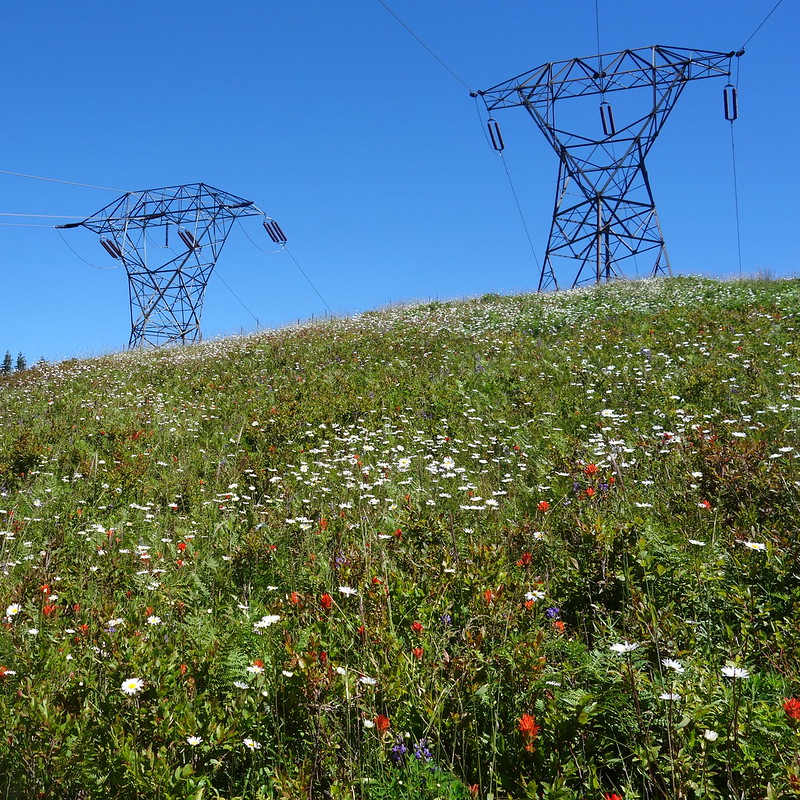
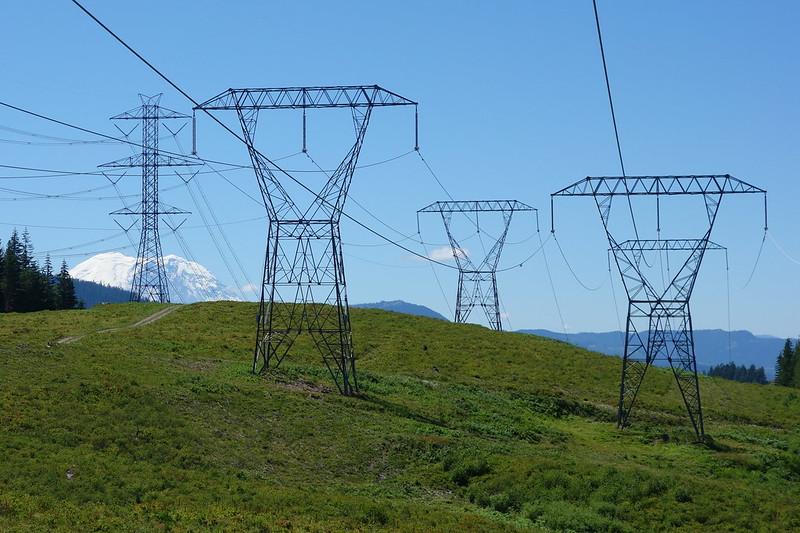
After breakfast the day passed quickly, as the trail and I wandered across countless roads, barren slopes, and occasional oases of untouched trees. Eventually we crossed Yakima Pass and Twilight Lake, climbed up a small granite slope, and were there: Mirror Lake, in its massive basin under Tinkham Peak. I set up camp in a developed site on the far side, and jumped in the water wearing all my clothes. It was bracingly cold but the afternoon had become quite hot, and I happily swam out toward the middle, looking up at the wooded, granite-lined shores. Paradise.


As I was falling asleep that night, after a large, long dinner at the water's edge, I heard a strange plunking sound from the lake. Looking out, I saw fish jumping for flies, and felt, for the first time since leaving Norse Peak, that I was in the right place.
Day 12 (July 28): Mirror Lake to Snoqualmie Pass
PCT 2382.1 - 2390.7 (8.6 miles)
The next morning I had a very long breakfast at camp, sitting on the shore with my feet in the water, then finally, reluctantly, packed up my stuff.
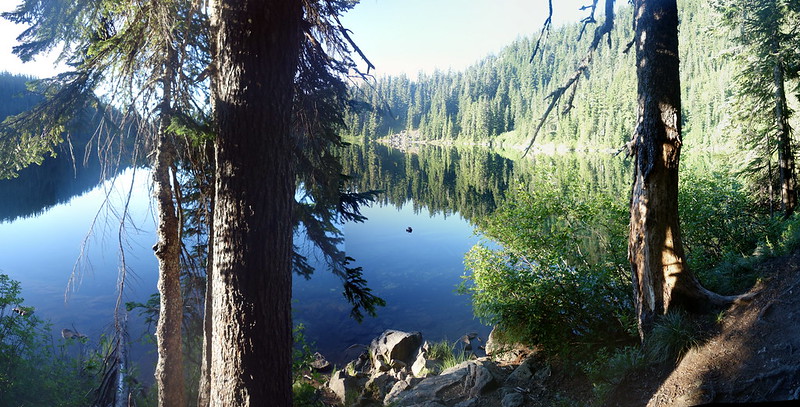
It was only eight or nine miles to Snoqualmie Pass, and after breaking camp I walked fast, led by images of hot food and a hotel room. The trail was beautiful though: no longer pocked by roads and empty slopes, but full of springs and trees and flowers.
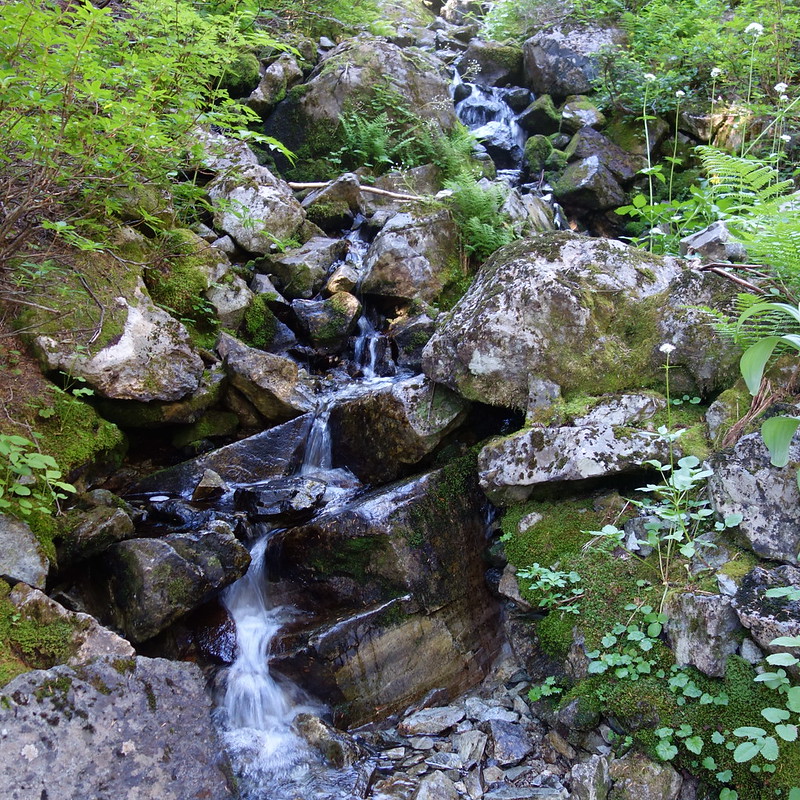
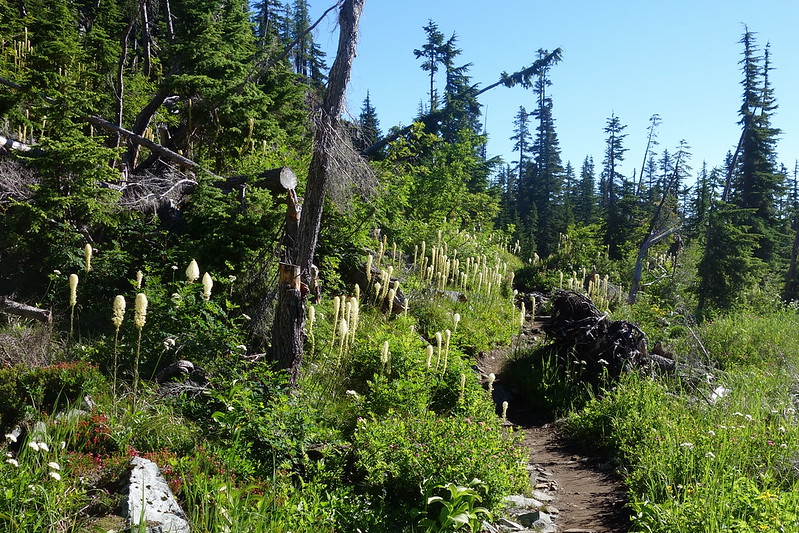
A couple hours later, I reached the southern tip of Snoqualmie's ski resort, and descended through its flower filled runs to the highway and a little line of shops.
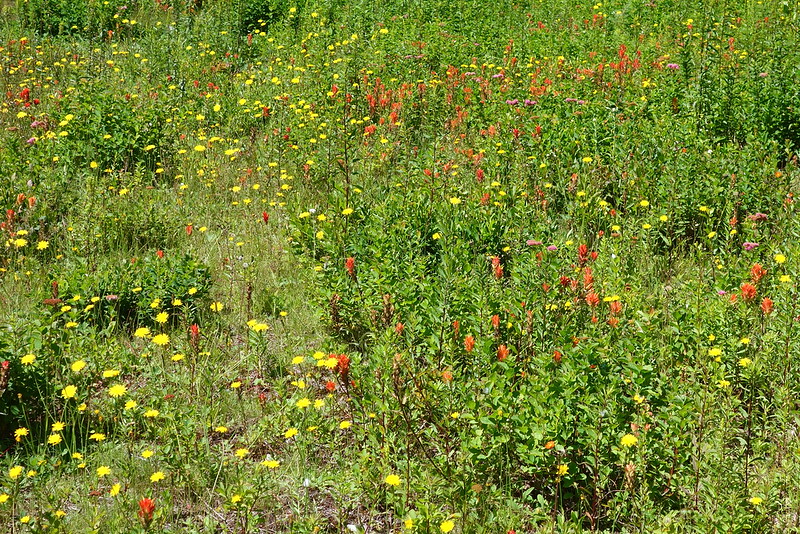
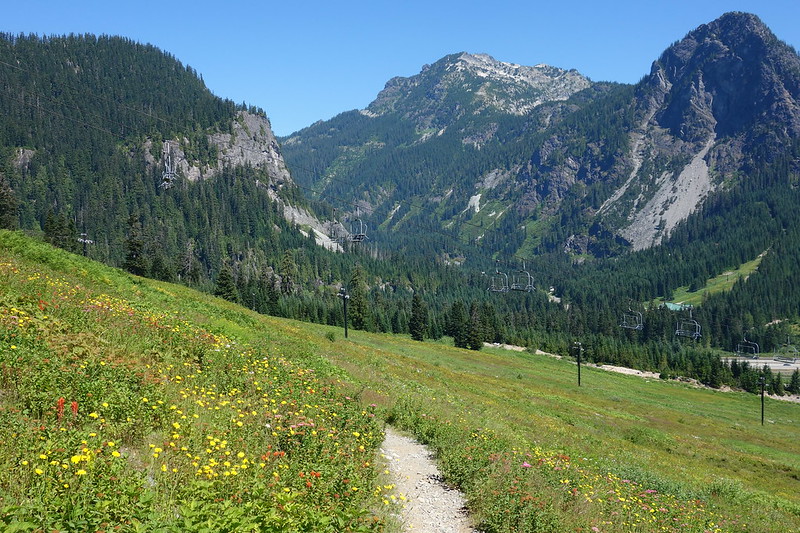
I stopped first at the Chevron Station, which doubles as a contract Post Office, to which Krista had sent me a resupply package via General Delivery. It was there, stacked with others, unguarded, in a disused cooler in back. Then to the Inn, where I reserved a room for the night, and to The Aardvark, a famous hiker-friendly food cart in the Chevron parking lot, whose owner, Dan the Man, seems to run the place largely as a way of getting to spend every day drinking with hikers. Before I'd even ordered, he offered me a free beer, and I spent hours there eating his inexplicably delicious, Asian-inspired food, drinking beer, and rummaging through my resupply.
Along with food and all that, Krista had sent a picture of us from our wedding. I was sweaty and nervous in a nice new shirt and tie. She was beautiful and seemingly put at ease by my obvious discomfort. I sat in the parking lot for a while staring at it, then checked into the hotel, and spent the evening eating pizza pockets in the bath and talking to her on the phone. Several times, I almost fell asleep in the Inn's soft bed, the phone still on and against my ear.